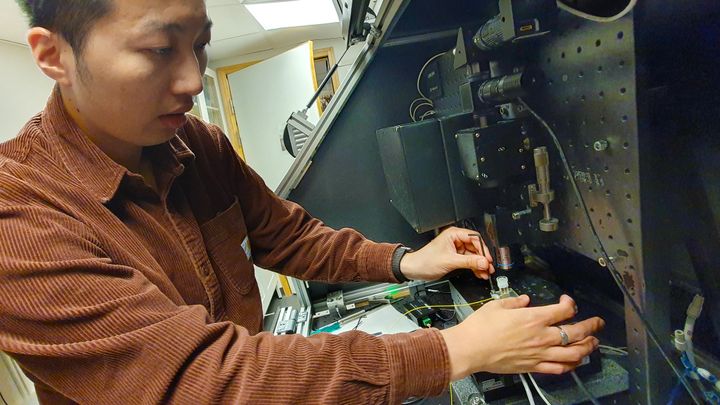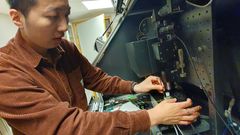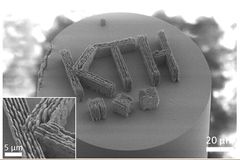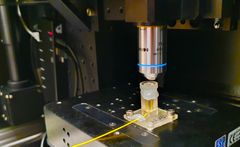1,000 times smaller than a grain of sand—glass sensors 3D-printed on optical fiber
In a first for communications, researchers in Sweden 3D printed silica glass micro-optics on the tips of optic fibers—surfaces as small as the cross section of a human hair. The advance could enable faster internet and improved connectivity, as well as innovations like smaller sensors and imaging systems.

Reporting in the journal ACS Nano, researchers at KTH Royal Institute of Technology in Stockholm say integrating silica glass optical devices with optical fibers enables multiple innovations, including more sensitive remote sensors for environment and healthcare.
The printing techniques they report also could prove valuable in production of pharmaceuticals and chemicals.
KTH Professor Kristinn Gylfason says the method overcomes longstanding limitations in structuring optical fiber tips with silica glass, which he says often require high-temperature treatments that compromise the integrity of temperature-sensitive fiber coatings. In contrast to other methods, the process begins with a base material that doesn't contain carbon. That means high temperatures are not needed to drive out carbon in order to make the glass structure transparent.
The study's lead author, Lee-Lun Lai, says the researchers printed a silica glass sensor that proved more resilient than a standard plastic-based sensor after multiple measurements.
"We demonstrated a glass refractive index sensor integrated onto the fiber tip that allowed us to measure the concentration of organic solvents. This measurement is challenging for polymer-based sensors due to the corrosiveness of the solvents," Lai says.
"These structures are so small you could fit 1,000 of them on the surface of a grain of sand, which is about the size of sensors being used today," says the study's co-author, Po-Han Huang.
The researchers also demonstrated a technique for printing nanogratings, ultra-small patterns etched onto surfaces at the nanometer scale. These are used to manipulate light in precise ways and have potential applications in quantum communication.
Gylfason says the ability to 3D print arbitrary glass structures directly on fiber tip opens new frontiers in photonics. "By bridging the gap between 3D printing and photonics, the implications of this research are far-reaching, with potential applications in microfluidic devices, MEMS accelerometers and fiber-integrated quantum emitters," he says.
Images



Subscribe to releases from KTH Royal Institute of Technology
Subscribe to all the latest releases from KTH Royal Institute of Technology by registering your e-mail address below. You can unsubscribe at any time.
Latest releases from KTH Royal Institute of Technology
Study explains why new kinds of steel needed to build lead cooled reactors11.12.2025 14:23:59 CET | Press Release
Safer operation, better fuel efficiency and lower waste mark lead-cooled nuclear power as a potentially dramatic shift from the water-cooled nuclear stations the world has relied on since the mid 20th century. A recent Swedish study casts new light on how to avoid corrosion in the steel used to build these next-generation nuclear facilities.
Alternative to BPA passes toxicity and sustainability standards set by EU innovation guidelines4.12.2025 11:07:37 CET | Press Release
Polyester and a host of other plastic products could potentially be manufactured with non-toxic and sustainable BPA alternatives identified in a multidisciplinary study published today by researchers in Sweden.
Study shows potential for more affordable and efficient hydrogen gas production3.12.2025 15:29:35 CET | Press Release
A recent advance in the science of hydrogen fuel production could enable higher output and more sustainable production of this renewable energy source, researchers with Stockholm’s KTH Royal Institute of Technology report.
Calcium-sensitive switch designed to boost efficacy of cancer drugs24.11.2025 21:11:53 CET | Press Release
Cancer-fighting antibody drugs are designed to penetrate tumor cells and release a lethal payload deep within, but too often they don’t make it that far. A new study shows how this Trojan Horse strategy works better by exploiting calcium differences outside and inside cells.
Potential treatment may prevent brain damage in premature babies11.11.2025 11:10:46 CET | Press Release
A treatment that could protect premature babies from brain damage showed promise in a recent study in Sweden. Using a first-of-its-kind prenatal brain model created with human cells, researchers observed new details about the effects of cerebral hemorrhages on stem cells during premature birth. And they successfully tested an antidote that reduced the damage.
In our pressroom you can read all our latest releases, find our press contacts, images, documents and other relevant information about us.
Visit our pressroom